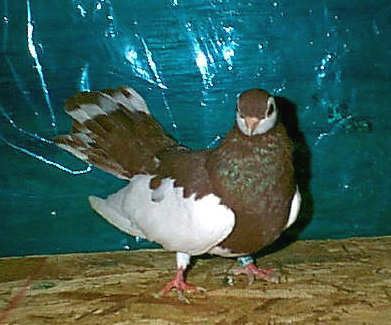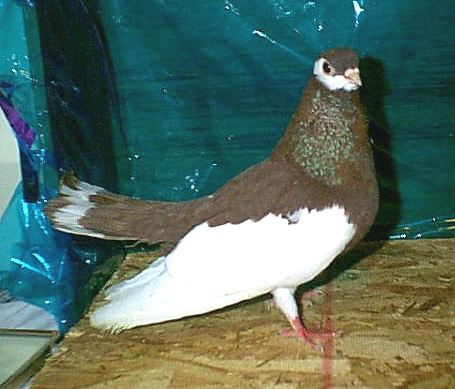|
|
|


The Rzhevski Startailed Turmani: Gem of the Russia's
By K. D. Spurling (1998)
Perhaps of Russia's over 170 races of Domestic Pigeons, the Rzhev Startailed Turmans are the best known and most popular throughout the world. With enthusiastic breeders in Russia, Poland, Romania, Germany, Holland, Britain and the United States; it is easily one of the most famous of rare varieties.
The Rzhev Startail is named for the city of Rzhev, which is located approximately 75 miles north of Mocsow. Together with Kaluga and Tula, they form a semi circle around Moscow; and it is here in these four cities that exist the very heartland of Turman culture in the world. It is said that the first Turmans actually came to Moscow as the spoils of defeated Turkish held cities in the Ukrain during the reign of Princess Olga of Moscow. (About 940 AD.). This original ancestor is said to have been obtained by the Turks in what is today Afghanistan and they are generally referred to as "Turmani Afghan". Likely, this original breed has become extinct as it has not yet been located in Afghanistan, Turkey or other parts of the Middle East and because of this, we have no genuine proof that the original birds came from any part of the Middle East regions.
The Rzhev Startails are vivid and delicate pigeons of a shy temperment, about the size of a Birmingham Roller. The head is nearly square in shape with rounded edges and a high and steeply rising frontal. The birds may be plainheaded, but lesser known are the shell crested specimens as seen in the accompanying figure which was reproduced from Russian literature. The cere is fine and pale in color, surrounding large expressive bull eyes. The beak is blunt, medium short in length and set somewhat down-faced. The neck is of medium length and tapers towards the shoulders and flows into the long, sweeping back. The tail is long and slightly fanned, consisting of 12 to 14 retrices, and slightly elevated. The wings are carried below the tail, but must not touch the floor. The toes are short and thick and always free of plumage.
Historically, the Rzhev Startails come in Red and Yellow. However, in the Russian way of thinking, this is not correct. In Russia, only the reds would be considered Rzhev Turmani. This is easily proven just by translating the Russian name: "Rzhevski Krasno Pegije Turmani' (Rzhev Red Pegije Turman). Yellow birds of this style do exist, but in Russia these birds are known as "Morshanski Schulto Pegije Turmani" (Morshank Yellow) and are considered a seperate, but closely allied breed. The red should be as shiny and brilliant as possible, and among all races of pigeons no other red pigeon can equal the color quality of an excellant Turman. Some Turmans maintain such rich, even and out-right awesome red plumage that in photos or from a short distance they may appear black. The type of red plumage the Turmans have is a refined Ash Red with Lebanon Bronzing.
If producing the ideal Rzhevski type and color quality were not difficult enough, we also add to this the vibrant and flashy markings. The marking is called "Pegije" and is similiar to the Magpie and Gansel markings seen in other races of tumblers. The difference between it and the other two is manifested in the head markings. White is a circle around the eyes, the cheeks and a small beard upon the head. The head marking is generally referred to as the mask, and it is my opinion that these head markings are genetically of the same type as the Aachen Band Croppers. Also white are the wings (save shoulders), the belly, thighs and a white band in the tail. Colored is the rest of the head, neck, breast, back, rump, shoulders, support feathers (so called "wedge"), vent fluff and tail up to the white band. The tip of the tail is also edged in color. Great troubles have been had in producing good markings, even if a fancier owns a very good stude Many birds have troubles with white or mix colored backs and also support feathers. These are severely faulty, even tho markings are not of primary importance. However, 99% of all birds have troubles with the facial markings even in the best lofts. I have seen many that are near perfection on one side, only to less than acceptable on the other eye. I have bred over 300 breeds of Pigeons and nowhere else in the pigeon world have I discovered a breed with a more difficult marking. I have heard hundreds of fanciers claim that their breed represents the ultimate challenge of pigeon breeding. I have to smile a bit at them, for I have seen dozens of very experienced and very successful fanciers of other marked pigeons try and quickly fail with Rzhev even tho they began with excellent birds. I have heard it said that the breeder of marked pigeons "must be a glutton for punishment" and if this is true, then we Turman breeders must be the worst kind of mental masochists to year after year strive for perfection and year after year just fall short.
However, this is not to say that good Turmans represent an impossibility. I myself have been more than pleased with my own successes. In 1995, my late partner Gary Blain and I bred a hen that in back to back shows won Grand Champion Rare Breed under very strict competition,. and no other member of the breed had ever won a Grand Champion Rare in the U.S.A .over its 30 year history in the United States. 1997 was a banner year in breeding and I produced three that came very close. In Feb.'98, one hen took Res. Grand Champion SE-Russian at a California State meet, only to lose out to one of my Kazans. (The Kazan also went Grand Champion Rare and Best In Show of all variety under John Heppner as judge). In June '98 this same hen also took Grand Champion SE-Russian at another California State meet. Also in June, her full brother won Res. Grand Champion Rare at a California Stat. RBPC meet. Then in Noveuber, another cock took Best Rzhev in a tough and large class for the breed and also Grand Champion at Western Regional meet here in Southwest Oregon - which was a record breaker in size. So despite the great difficulties, it is possible to be heavily competitive with the breed. The greatest advice I can give to a fancier is to study the breed and its official standard, seek out the best stock, breed best to best, linebreed around your best, cull ruthlessly, work with only the best and keep the stud small and lastly, to have patience.
A question that I am very often asked is: "Do they fly?". Indeed they fly, and they fly better than most rare breeds. In fact, their history in the air is legend around Moscow. These pigeons were flown in three birds kits from small wooden boxes to the upper altitudes for 4 to 7 hours. The birds should be flown in this fashion and managed strictly. In some American and German literature the birds are regarded as tumblers and I have seen some that will tumble. However, this is not aspired for in Moscow and the surroundings - the heartland of Turman breeding. By the old and true ideal set forth by the old Turman breeders, the birds should fly well in loose kits; gliding, soaring, wing clapping. Most importantly, the birds are to hover in one spot and flashing their vibrantly marked tails in play to please the eyes of onlookers. And is this not something of which the old Moscow breeders can be proud?
Something like a traditional mark: "Made In Russia."
Vote For Us at Pigeon Paradise Top 100!!!!
This site is owned by: K.D. Spurling/Impreska
Turmani (REG'D)
Winner of the 1999 and 2000
Bondarov Memorial Award for Turmani Excellence